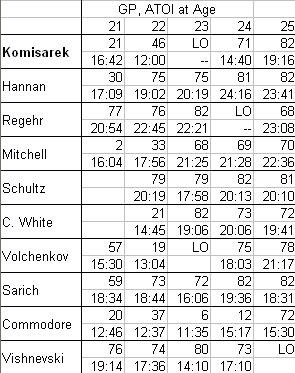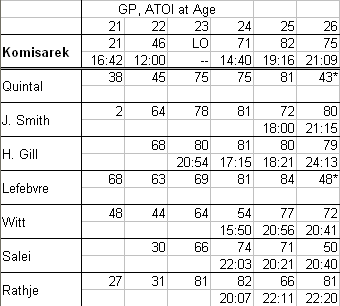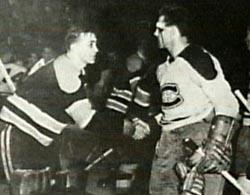Projecting Komisarek
We're verging on blindfolded darts here - this one is even less exact than Chipchura.
Komisarek is quite clearly a defensive defenceman. I thought it would be hard to come up with similar players but I'm pleased with these lists of past and present defensive defencemen. Rather than points, I used games played and ATOI.

Regehr and Hannan are way ahead of Komi in terms of development. They're among the cream of the crop of shutdown defencemen. Hannan's cap hit is $4.5M. Next season Regehr starts a 5 year extension worth $4M per.
Mitchell and Schultz are a tier down, and still appear to have progressed more rapidly than Komisarek. How much of that can be credited to playing on top defensive teams? Mitchell signed for 4 years at $3.5M two years ago. Schultz just signed for 5 years, also at $3.5M.
Colin White cracked a deep New Jersey blueline at a younger age than Komisarek. Two seasons ago he signed for $3M over 6 years.
I think Volchenkov is the best comparison among Komi's contemporaries - a top pair, right-side hitter/shot blocker. Their development curves are pretty close too. He signed his final RFA contract last season, for $2.5M over 3 years.
Sarich is a RHS whose development might be a little behind Komi's. He got lots of minutes on the AHL-calibre defense in Tampa. Last summer he signed for $3.6M over 5 years as an UFA.
Commodore and Vishnevski are a rung or two below Komisarek. Vishnevski got $1.8M per as an UFA and we'll see how Commodore fares this summer.

These are some players whose early seasons were similar to Komisarek's, just to get a feel for how his career might play out. Jason Smith and Brendan Witt progressed at a rate similar to Komi.
Being paired with the team's best defenceman gives his numbers a boost, so the potential is there for an overpayment on the UFA market next summer.
Komisarek is quite clearly a defensive defenceman. I thought it would be hard to come up with similar players but I'm pleased with these lists of past and present defensive defencemen. Rather than points, I used games played and ATOI.

Regehr and Hannan are way ahead of Komi in terms of development. They're among the cream of the crop of shutdown defencemen. Hannan's cap hit is $4.5M. Next season Regehr starts a 5 year extension worth $4M per.
Mitchell and Schultz are a tier down, and still appear to have progressed more rapidly than Komisarek. How much of that can be credited to playing on top defensive teams? Mitchell signed for 4 years at $3.5M two years ago. Schultz just signed for 5 years, also at $3.5M.
Colin White cracked a deep New Jersey blueline at a younger age than Komisarek. Two seasons ago he signed for $3M over 6 years.
I think Volchenkov is the best comparison among Komi's contemporaries - a top pair, right-side hitter/shot blocker. Their development curves are pretty close too. He signed his final RFA contract last season, for $2.5M over 3 years.
Sarich is a RHS whose development might be a little behind Komi's. He got lots of minutes on the AHL-calibre defense in Tampa. Last summer he signed for $3.6M over 5 years as an UFA.
Commodore and Vishnevski are a rung or two below Komisarek. Vishnevski got $1.8M per as an UFA and we'll see how Commodore fares this summer.

These are some players whose early seasons were similar to Komisarek's, just to get a feel for how his career might play out. Jason Smith and Brendan Witt progressed at a rate similar to Komi.
Being paired with the team's best defenceman gives his numbers a boost, so the potential is there for an overpayment on the UFA market next summer.


3 Comments:
Why GP and ATOI? Aren't those closely related to the relative talent of their respective teams? For shutdown dmen, would Corsi numbers and the like be a better measure? Or maybe even just blocked shots and hits?
Why GP and ATOI?
Just because I can search by GP in the hockey-reference player season finder. Once I narrow it down, I can eyeball those with similar ATOI. Pretty crude, I know. If I called this an inexact science, it would be an insult to inexact sciences. It's more like hand-wavey BS. :)
The more advanced stats just aren't available for enough seasons. For the seasons they are available, it's too much work to track down those with similar rates.
The quality of other teams is definitely a factor in how many games/minutes a guy gets. The same is true for forwards - it would affect their ppg. Then you have to consider that easing a player into a solid roster like Detroit's might inflate his numbers. Also, Montreal has a culture of bringing prospects along verrry slowly. There are lots of factors you just can't accurately account for, so take these posts with a big grain of salt.
Please feel free to mention past/present players you think are comparable to these guys, too.
There basically are no good statistics to measure a guy like Komisarek. There are a lot of stats that tell you somehting, but don't show the whole picture.
Ice time is decent, but it relies on the coach's opinion. Also it's worth thinking about special teams time. A guy like Komisarek isn't going to spend a lot of time on the PP on a team like Montreal, but on a team that's not been blessed with Sourays, Streits, or Markovs, a coach might be tempted to use him at the point and see if he can work on his shot.
Hits and blocked shots are nice, too, but again, they're indicative of a style of play and how good he is at it. Lidstrom doesn't rack up huge numbers there, and nobody can question the quality of his defensive game. Still, the fact that Komi was first and second in those stats is indicative.
Corsi numbers are all well and good, but they're a lot like plus-minus in that it's a team stat, and it's affected by strength of teammates, strength of opposition, and just plain style of play. Montreal has a very shot-efficient offense and a defense that concedes low-percentage shots, so that tends to drive shot-based metrics like Corsi numbers down.
Goals against per 60 minutes on ice is a metric that looks great on the surface, but is terribly flawed. If Markov allows say 2.82 goals/60 and O'Byrne allows 1.97, does that make O'Byrne better defensively? Even if you consider that Markov plays against the Evgeni Malkins and O'Byrne plays against the Jarkko Ruutus?
There just isn't a good way to statistically measure defense. And the game is so fluid and organic there may very well never be.
That makes finding comparables hell. Volchenkov is a very good match though. He's a top-pairing D-man with size who hits and blocks shots. This is actually a vanishing breed in the NHL.
Post a Comment
<< Home